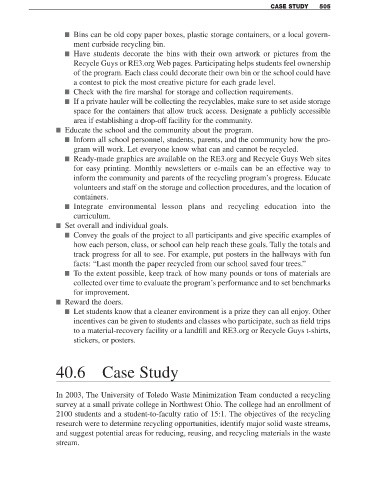Page 527 - Solid Waste Analysis and Minimization a Systems Approach
P. 527
CASE STUDY 505
■ Bins can be old copy paper boxes, plastic storage containers, or a local govern-
ment curbside recycling bin.
■ Have students decorate the bins with their own artwork or pictures from the
Recycle Guys or RE3.org Web pages. Participating helps students feel ownership
of the program. Each class could decorate their own bin or the school could have
a contest to pick the most creative picture for each grade level.
■ Check with the fire marshal for storage and collection requirements.
■ If a private hauler will be collecting the recyclables, make sure to set aside storage
space for the containers that allow truck access. Designate a publicly accessible
area if establishing a drop-off facility for the community.
■ Educate the school and the community about the program.
■ Inform all school personnel, students, parents, and the community how the pro-
gram will work. Let everyone know what can and cannot be recycled.
■ Ready-made graphics are available on the RE3.org and Recycle Guys Web sites
for easy printing. Monthly newsletters or e-mails can be an effective way to
inform the community and parents of the recycling program’s progress. Educate
volunteers and staff on the storage and collection procedures, and the location of
containers.
■ Integrate environmental lesson plans and recycling education into the
curriculum.
■ Set overall and individual goals.
■ Convey the goals of the project to all participants and give specific examples of
how each person, class, or school can help reach these goals. Tally the totals and
track progress for all to see. For example, put posters in the hallways with fun
facts: “Last month the paper recycled from our school saved four trees.”
■ To the extent possible, keep track of how many pounds or tons of materials are
collected over time to evaluate the program’s performance and to set benchmarks
for improvement.
■ Reward the doers.
■ Let students know that a cleaner environment is a prize they can all enjoy. Other
incentives can be given to students and classes who participate, such as field trips
to a material-recovery facility or a landfill and RE3.org or Recycle Guys t-shirts,
stickers, or posters.
40.6 Case Study
In 2003, The University of Toledo Waste Minimization Team conducted a recycling
survey at a small private college in Northwest Ohio. The college had an enrollment of
2100 students and a student-to-faculty ratio of 15:1. The objectives of the recycling
research were to determine recycling opportunities, identify major solid waste streams,
and suggest potential areas for reducing, reusing, and recycling materials in the waste
stream.

